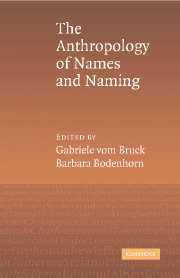Book contents
- Frontmatter
- Contents
- Contributors
- Preface and Acknowledgments
- 1 “Entangled in Histories”: An Introduction to the Anthropology of Names and Naming
- 2 “Your Child Deserves a Name”: Possessive Individualism and the Politics of Memory in Pregnancy Loss
- 3 Why the Dead Do Not Bear Names: The Orokaiva Name System
- 4 The Substance of Northwest Amazonian Names
- 5 Teknonymy and the Evocation of the “Social” Among the Zafimaniry of Madagascar
- 6 What's in a Name? Name Bestowal and the Identity of Spirits in Mayotte and Northwest Madagascar
- 7 Calling into Being: Naming and Speaking Names on Alaska's North Slope
- 8 On Being Named and Not Named: Authority, Persons, and Their Names in Mongolia
- 9 Injurious Names: Naming, Disavowal, and Recuperation in Contexts of Slavery and Emancipation
- 10 Where Names Fall Short: Names as Performances in Contemporary Urban South Africa
- 11 Names as Bodily Signs
- Bibliography
- Index
1 - “Entangled in Histories”: An Introduction to the Anthropology of Names and Naming
Published online by Cambridge University Press: 17 August 2009
- Frontmatter
- Contents
- Contributors
- Preface and Acknowledgments
- 1 “Entangled in Histories”: An Introduction to the Anthropology of Names and Naming
- 2 “Your Child Deserves a Name”: Possessive Individualism and the Politics of Memory in Pregnancy Loss
- 3 Why the Dead Do Not Bear Names: The Orokaiva Name System
- 4 The Substance of Northwest Amazonian Names
- 5 Teknonymy and the Evocation of the “Social” Among the Zafimaniry of Madagascar
- 6 What's in a Name? Name Bestowal and the Identity of Spirits in Mayotte and Northwest Madagascar
- 7 Calling into Being: Naming and Speaking Names on Alaska's North Slope
- 8 On Being Named and Not Named: Authority, Persons, and Their Names in Mongolia
- 9 Injurious Names: Naming, Disavowal, and Recuperation in Contexts of Slavery and Emancipation
- 10 Where Names Fall Short: Names as Performances in Contemporary Urban South Africa
- 11 Names as Bodily Signs
- Bibliography
- Index
Summary
Immediately after the attack on the World Trade Center in September 2001, naming the victims and the culprits became an urgent matter. Lists of names – of living and dead – were posted daily. For some time there were names that could not be put with certainty in either category. And there were daunting traces of human bodies that could not be attached with certainty to a particular name. “It is terrible to think that a person will go into the ground … [without] a name,” Susan Black, a forensic anthropologist, said in a different context, adding that once the bodies are identified, families can begin mourning. Similarly, Thomas Laqueur has argued that finding and naming the Bosnian victims of genocide in the 1990s seemed the only emotionally possible beginning for a survivor's new life.
Although most of those who perished in the World Trade Center attack were eventually named, many families had, literally, no body to bury. On the other hand, the “true” names of most of the perpetrators remained unknown. Passports attributed to attackers failed to provide adequate clues, many stolen from people far from the scene. In this instance naming was put to the task of establishing moral accountability, while the mistaken attribution of guilt was vehemently rejected by those who felt wronged.
The need to identify the dead by name in New York links, in a very different context, with its polar opposite – the act of de-naming as a form of political annihilation.
- Type
- Chapter
- Information
- An Anthropology of Names and Naming , pp. 1 - 30Publisher: Cambridge University PressPrint publication year: 2006
- 7
- Cited by



